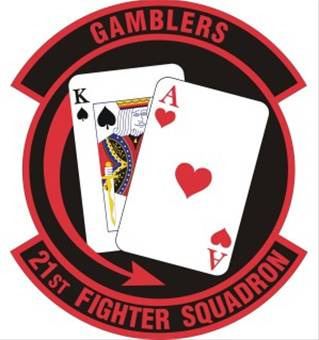 | ||
Active 15 October 1944 – 15 October 194611 November 1954 – 15 March 19591 December 1972 – 28 June 19911 November 1991 – 31 December 19938 August 1996 – present Part of Air Education and Training Command19th Air Force56th Fighter Wing56th Operations Group | ||
The 21st Fighter Squadron (21 FS) is part of the 56th Operations Group at Luke Air Force Base, Arizona. It operates the F-16 Fighting Falcon aircraft conducting advanced fighter training for the pilots of the Republic of China (Taiwan) Air Force.
Contents
Mission
The 21st Fighter Squadron, 'The Gamblers', operate the Block 20 F-16A/B for the Republic of China Air Force (ROCAF), under a three-year pilot training programme called 'Peace Fenghuang'. This is the only squadron at Luke to operate the original F-16 variant, which are unusual in being 93 fiscal year serial new build Block 20 aircraft.
The squadron is to:
Prior to reforming at Luke in 1997, the 21st Tactical Fighter Training Squadron operated F-4E Phantom IIs at George AFB, California until 1993.
World War II
The unit was activated in October 1944 as a Very Long Range P-47N Thunderbolt fighter-escort squadron for B-29 Superfortress units engaged in the strategic bombardment of the Japanese Home Islands. It trained under the Third Air Force in the southeast United States and deployed to the Pacific Theater, being assigned to Okinawa in May 1945.
The squadron began operations from Ie Shima in June. It engaged in dive-bombing and strafing attacks on factories, radar stations, airfields, small ships and other targets in Japan. It made several attacks on shipping and airfields in China during July. The unit flew its only escort mission on 8 August 1945 when it escorted B-29s during a raid against Yawata, Kyoto, Japan.
After the end of combat in the Pacific, it remained on Okinawa as a part of the air defense and occupation force for the Ryukyu Islands after the war. The unit was inactivated on Okinawa on 15 October 1946.
Cold War
Reactivated in August 1954 under Tactical Air Command and equipped with F-86 Sabres at George AFB, the unit was re-equipped with the F-100 Super Sabre in 1956 and trained in operational proficiency as a Tactical Fighter Squadron, its aircraft carried a blue marking motif. The squadron was inactivated on 15 March 1959 for budgetary reasons, its aircraft were reassigned to the incoming 31st TFW being moved from Turner AFB, Georgia.
The unit was reactivated in 1972 as a "wild weasel" Tactical Fighter Training radar detection and suppression outfit at George AFB, replacing the provisional 4535th Combat Crew Training Squadron. It trained in Wild Weasel operations with F-4C Phantom IIs carrying the tail code "GA", upgrading to the F-4E in 1975 for aircrews who were newly assigned to the aircraft or who were returning to the aircraft from staff positions. The squadron was tasked with training pilots for PACAF (the Pacific Air Forces) and continued to do so until 1991. It was inactivated in June 1991 as part of the close-down of George AFB.
It was reactivated at Shaw AFB, South Carolina in November 1991, where it received A-10A Thunderbolt IIs from the inactivating 354th Fighter Wing at Myrtle Beach AFB, South Carolina, the aircraft being re-designated as the OA-10A Thunderbolt forward air control. It was inactivated in December 1993 along with the 363d Fighter Wing when the 20th Fighter Wing moved back to the United States from RAF Upper Heyford, England, assuming the assets of the 363d FW.
Modern era
The squadron was reactivated in August 1996 to train ROCAF F-16A/B crews at Luke AFB, Arizona. Empty hangars were refurbished and aircrews were pulled-in from other units on base. By January 1997 several F-16A/B block 20s had been delivered and the first training flights began for the Republic of China Air Force crews. The program became known as Peace Fenghuang which is Chinese for 'Phoenix.' Twenty of these aircraft were initially made available, but the numbers have fluctuated over the years, mostly less aircraft for training.
Although flying what could be considered an older version of the F-16, it is more advanced than most other Falcons being flown from Luke AFB. As the first block 20 was only rolled off the production line at Fort Worth, Texas in July 1996, these aircraft had not been tested like other blocks before going to an active training unit. Two aircraft were sent to Edwards AFB, California, for testing while training continued at Luke AFB. Because of this, in the early years the unit liaised with Lockheed frequently.
Training in the 21st Fighter Squadron is a combination of classroom time and flying. For students, the flying involves amassing fifty flights, starting with basic maneuvers to more advanced combat in both aerial engagements and bombing tactics. A program to train instructor pilots is also in place. The first class of pilots graduated in July 1997 and the first instructor pilots graduated in June 1998.
